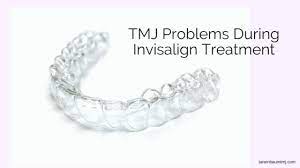Yes, Invisalign can Cause TMJ and Teeth Clenching. Any orthodontic treatment that causes the teeth to move around, the space in the mouth to be reduced (closing spaces) or the the bite to change can cause teeth clenching. And Invisalign can cause all of these changes. Even braces can cause TMJ symptoms.
TMJ and teeth clenching is caused by a poor and imbalanced bite. And cases where the mouth is not large enough for the tongue to fit and posture properly. Invisalign is often used to close spaces between teeth and move them back. In these cases the tongue can be crowded and the bite is compressed and usually people will start clenching as a result.
Invisalign can be the cause or the cure of TMJ teeth clenching depending on how it is used. You are relying on the expertise of your dentist. Invisalign is just an orthodontic device. You dentist needs to diagnose your problem and use Invisalign or other treatment to fix it.
Contact us for a consultation especially if you are clenching your teeth and sleeping poorly.

Dr Gary Adams
Invisalign and Teeth Clenching: What You Need to Know
Invisalign has become a popular alternative to traditional braces for correcting dental alignment issues. However, some people have experienced TMJ pain after starting Invisalign treatment. In this post, we’ll explore the connection between Invisalign and TMJ pain, whether Invisalign can help or cause TMJ issues, and how to manage TMJ pain during treatment.
TMJ and teeth clenching can also be caused by airway and mouth breathing problems. As is the case with sleep apnea. An expander such as a DNA appliance or Homeoblock device are the better appliances when there is mouth breathing, sleep issues and teeth clenching at night.
Invisalign Orthodontics vs Palatal Expansion

Understanding Teeth Clenching and Invisalign Relationship
Temporomandibular joint (TMJ) disorders affect the hinge-like joint connecting the jaw to the skull. TMJ pain may result from issues with the joint or the muscles controlling jaw movement. Symptoms include pain, clicking or popping sounds, and difficulty chewing.
Invisalign is an orthodontic treatment that uses a series of clear, removable aligners to straighten teeth. Invisalign treatment can affect the jaw, as it repositions teeth to improve alignment and bite. Teeth alignment can influence TMJ function, making it crucial to understand the connection between Invisalign and TMJ pain. The cost of Invsialign is worth it when everthing goes as planned.
Teeth Clenching and Jaw Pain: Causes and Management
Invisalign may cause jaw pain for some individuals. This discomfort may arise from teeth movement or changes in bite alignment, placing stress on the TMJ. Additionally, the pressure exerted by the aligners can lead to jaw clenching, causing pain in the jaw and ear area.
Why Do People Start Clenching Their Teeth with Invisalign?
Clenching is a common response to the pressure applied by Invisalign aligners as they work to shift teeth into proper alignment. This pressure can cause discomfort, leading some individuals to subconsciously clench their teeth to cope with the sensation. Furthermore, the new alignment may alter how the teeth fit together, creating an unfamiliar bite that could trigger clenching as the jaw muscles attempt to find a comfortable position.
Management of jaw pain during Invisalign treatment:
- Review Invisalign treatment plan to be sure the bite relationship and tongue spaces have been optimized
- Consult your orthodontist to ensure the aligners fit properly and address any concerns
- Practice relaxation techniques to reduce jaw clenching
- Use over-the-counter pain relievers, if necessary
Invisalign and Jawline Aesthetics
Invisalign can improve jawline appearance by correcting dental alignment and bite issues. However, in some cases, individuals may feel that their jawline looks worse due to the temporary changes in jaw position during treatment. This perception typically improves as the treatment progresses and the final results become apparent.
Does Invisalign Change the Size and Shape of the Jaw?
While Invisalign primarily focuses on repositioning teeth, it can indirectly influence the jaw’s size and shape as a result of correcting bite alignment. As teeth move into their proper positions, the jaw may adjust to accommodate the new alignment. However, these changes are usually subtle and may not lead to a dramatic transformation in the jaw’s size or shape. The primary goal of Invisalign is to create a harmonious relationship between the teeth and jaws, which can result in an improved overall appearance.
Serious Side Effects and Limitations of Invisalign
Although Invisalign is generally considered safe and effective, it has some limitations and potential side effects:
- Invisalign may not be suitable for severe cases of dental misalignment or complex bite issues
- Some patients report temporary speech changes or discomfort from aligner edges
- Rarely, patients may experience an allergic reaction to the aligner material
- Invisalign can improve mouth breathing but is not indicated for severe sleep apnea.
- A severe class III malocclusion will need orthognathic surgery, but in less severe cases Invisalign can move the lower jaw forward a bit.
The failure rate of Invisalign is relatively low, but treatment success depends on factors like patient compliance and the complexity of the case.
Who Should Get Invisalign
Not everyone is a suitable candidate for Invisalign. People with severe dental misalignment, complex bite issues, or insufficient oral hygiene may not be good candidates. Invisalign is suitable for most age groups, including adults, as long as the patient has healthy teeth and gums.
Invisalign Wear and Compliance
It’s essential to wear Invisalign aligners for the recommended 20-22 hours per day. If you forget to wear your aligners for one night, consult your orthodontist for guidance on how to proceed. Maintaining proper wear and care of your aligners is crucial for successful treatment.
Can Invisalign Improve the Upper and Lower Jaw Relationship?
In some cases, Invisalign can improve the relationship between the upper and lower jaw, particularly when the misalignment is due to the position of the teeth rather than the actual jawbone structure. If the lower jaw appears to be in a reverse position due to dental issues, such as an overbite, Invisalign can help correct the alignment by moving the teeth into a more favorable position.
However, if the discrepancy between the upper and lower jaw is primarily due to an underlying skeletal issue, Invisalign may have limited success in correcting the problem. In such cases, a combination of orthodontic treatment and orthognathic (jaw) surgery might be required to achieve the desired result.
It’s essential to consult with an experienced orthodontist to evaluate the specific situation and determine the most suitable treatment approach for addressing the relationship between the upper and lower jaw.
Closing Teeth Spaces with Invisalign Can Cause TMJ?
In some cases, using Invisalign for retraction and closing spaces between teeth can cause jaw pain and contribute to TMJ issues. The process of moving teeth into new positions can place stress on the surrounding structures, including the temporomandibular joint. As a result, some individuals may experience jaw pain or worsening TMJ symptoms during treatment.
However, it’s important to note that not all patients will experience jaw pain or TMJ issues during Invisalign treatment. The response to orthodontic treatment varies from person to person, and many individuals undergo Invisalign without any significant discomfort or complications.
Closing Spaces Between Front Teeth: Invisalign vs. Veneers
When deciding whether to close spaces between front teeth using Invisalign or dental veneers, it’s important to consider the specific circumstances and goals of each patient.
Invisalign is an orthodontic treatment that gradually moves teeth into the desired position to close gaps and improve alignment. This approach addresses the underlying issue by physically repositioning the teeth and may have additional benefits for overall oral health and function.
On the other hand, dental veneers are thin shells made of porcelain or composite resin material that are bonded to the front surface of the teeth. Veneers can be used to create the appearance of a more uniform, gap-free smile without actually moving the teeth. This option may be more suitable for patients who are primarily concerned with cosmetic improvements and do not have significant bite or alignment issues.
Each option has its own set of advantages and drawbacks:
- Invisalign offers a more conservative and comprehensive approach to correcting dental alignment and bite issues, which may lead to improved oral health and function.
- Dental veneers are a faster cosmetic solution that can instantly improve the appearance of the smile without the need for orthodontic treatment. However, veneers may require the removal of some tooth enamel, and they do not address any underlying functional issues.
It’s essential to consult with a dental professional, such as an orthodontist or cosmetic dentist, to determine which option is best suited to your individual needs and goals.
TMJ Pain Management and Lifestyle
To manage TMJ pain during Invisalign treatment, patients should:
- Apply heat or cold packs to the affected area
- Practice relaxation techniques and stress management to reduce jaw clenching
- Consider physical therapy, massage, or acupuncture for additional pain relief
Patients with TMJ pain should consult their orthodontist or dentist to discuss treatment options and potential modifications to their Invisalign plan.
Conclusion
Invisalign is an innovative orthodontic treatment that can offer several benefits, but it’s crucial to consider its potential impact on TMJ pain. Understanding the connection between Invisalign and TMJ pain, as well as the limitations and potential side effects of Invisalign, can help patients make informed decisions about their treatment. Consultation with a qualified orthodontist is essential for determining the best course of action for individuals with TMJ pain considering Invisalign.

